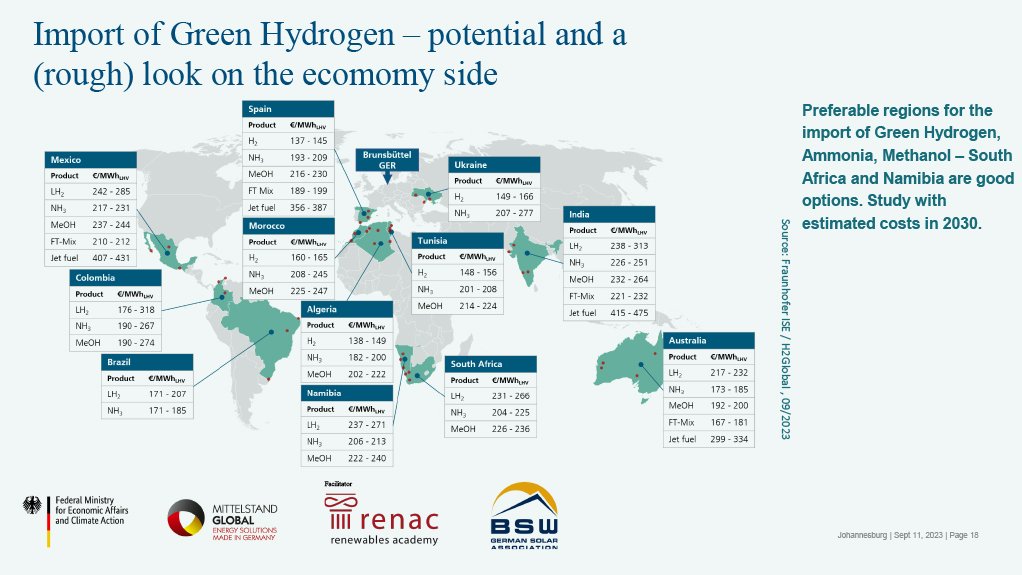JOHANNESBURG (miningweekly.com) – The implementation of study tours aimed at boosting the acceleration of green hydrogen development in South Africa forms the core of a tender which closes on December 8.
Mining Weekly can report that this is being done amid the ability of green hydrogen to create a significant new economy with a multiplicity of business models and opportunities, and a growing number of people coming to understand that green hydrogen is the champagne of the energy transition.
The knowledge-exchange tender has been called by the German sustainability organisastion Deutsche Gesellschaft für Internationale Zusammenarbeit (GIZ), which is a long-standing promoter of green hydrogen development in South Africa, through the Hydrogen South Africa project.
GIZ, working on behalf of the German Ministry for Economic Cooperation and Development, is inviting bids from companies with a local South African presence.
Despite the promising conditions for the development of a green hydrogen economy in South Africa, many are finding the uptake far less widespread than they could be and want any challenges that continue to persist to be tackled with urgency.
The GIZ tender is aimed at improving networking among institutions engaged with green hydrogen research, innovation and development within the Southern African region, where Namibia is certainly catching the eye. To be built in Namibia in the next ten months is a green hydrogen pilot plant and refuelling facilities to gain scientific insights into the implications of upscaling green hydrogen technologies.
GIZ wants the company that wins the study tours tender to engender an exchange of green hydrogen knowledge, good coordination, and maximum collaboration, which many believe to be urgent. Tender documents are available for downloading at https://www.giz.de/en/worldwide/133334.html
IMPORTANT FOR ENERGY TRANSITION
Green hydrogen and its derivatives ensure that green energy can be distributed over very long distances.
These can also provide the storage capacity that fluctuating renewable energy requires, given that the more fluctuating the renewable energy is, the greater the storage that will be needed.
Green hydrogen is also the first choice wherever more efficient battery technology is not advisable and whenever high efficiency does not play a key role, for example, in times of high renewable energy production and low demand.
It is only green hydrogen, which is hydrogen produced from renewable energies through electrolysis, that can help the world protect the climate in the most ubiquitous fashion.
ZERO-EMISSION LIVING
Last month, in an earlier tender, GIZ called for bidders to use its available green hydrogen toolkit to enhance green hydrogen in communities.
In that tender, it wanted the winning service provider to amplify green hydrogen at the smaller community end of the green hydrogen spectrum, to balance out the concentration at the big end of that spectrum.
The toolkit was described as a practical, user-friendly, and customisable community development instrument to support green hydrogen projects within a community development context.
This is aimed at ensuring that community development is not left out of the global advance towards zero-emission living as companies involved in realising zero-emission obligations typically deploy extensive expertise in renewable energies, green energy and green infrastructure.
Most projects have tended not to extend green hydrogen benefits to communities as much as is possible and the toolkit is highlighted as a pathway to improved green community inclusion, which is key if South Africa is to make inroads into the green hydrogen economy in an equitable and credible manner.
PLATINUM DEMAND
The large, opencast Mogalakwena mine in Limpopo is using green hydrogen to power its nuGen™ zero emission haulage solution, that is scheduled to be spread globally across the group.
Already collaborating in the trialling of hydrogen fuel cell electric vehicles (FCEVs) are Anglo American Platinum, BMW Group South Africa and Sasol South Africa. Within FCEVs, platinum catalysts convert green hydrogen into the zero-emission electricity that powers vehicles.
For South Africa, which is the largest supplier of platinum group metals (PGMs), the use of green hydrogen in the auto sector is an important development that could generate demand of up to five-million ounces of PGMs a year, if hydrogen fuel cells are used in 10% of the global car market. This will underpin job security for the 175 000 people employed in the PGMs mining sector.
In many countries, including South Africa, green hydrogen valleys with refuelling stations for green hydrogen FCEVs, are undergoing public-private partnership upliftment.
South African Mitochondria Energy Systems, headed by founder and CEO Mashudu Ramano, expects to break ground for a hydrogen development at the Vaal area in the first quarter of next year, with the first fuel cells being produced in 2024, and with full commercialisation expected in 2028.
South African company Hydrox Holdings, headed by CEO Corrie de Jager is of the view that green hydrogen produced on site can play a huge role in solving the energy crisis as it eliminates the challenges associated with establishing electrical distribution networks over vast distances.
“Access to dependable energy can be the catalyst to improving the lives of many and with access to electricity the potential of Africa’s people can be developed,” De Jager has pointed out to Engineering News & Mining Weekly.
“Many engineers and firms, including ourselves, have the technology and know-how to immediately implement hydrogen-related projects,” added De Jager.
At the big end, green hydrogen is being recognised globally as the most effective route towards combating the climate crisis holistically.
EMAIL THIS ARTICLE SAVE THIS ARTICLE ARTICLE ENQUIRY
To subscribe email subscriptions@creamermedia.co.za or click here
To advertise email advertising@creamermedia.co.za or click here













